
The specific date when the callsign was issued is not known, but it was issued in the year 1971.
Checkout this LINK for further information about the GURC and the newly formed Glasgow University Wireless Society.
All timeline stories.

The specific date when the callsign was issued is not known, but it was issued in the year 1971.
Checkout this LINK for further information about the GURC and the newly formed Glasgow University Wireless Society.
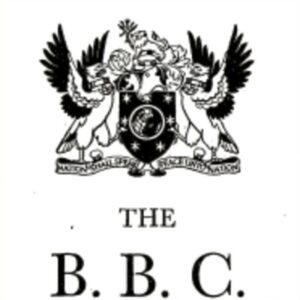
BACKGROUND
The British Broadcasting Company (Ltd), under the chairmanship of Lord Gainford, was formed in October 1922 to set-up a broadcasting system as outlined in a plan sanctioned by the Postmaster General in May 1922. This allowed eight areas of Britain to have a local transmitter of a power of 1.5kW. From this original scheme, the BBC developed the network of high power stations that became so familiar.
Initially eight stations were established.
(G)2LO – 14th November 1922 London (Marconi House) – 369 metres
(G)5IT – 15th November 1922 Birmingham (Witton) – 420 metres
(G)2ZY – 15th November 1922 Manchester (Trafford Park) – 385 metres
(G)5NO – 24th December 1922 Newcastle-Upon-Tyne – ? metres
(G)5WA – 13th February 1923 Cardiff – ? metres
(G)5SC – 6TH MARCH 1923 GLASGOW – 415 metres (722KHz)
(G)2BD – 10th October 1923 Aberdeen – ? metres
(G)6BM – 17th October 1923 Bounrnemouth (originally Plymouth)
Music quality landlines didn’t exist at first but simultaneous broadcasting started in May 1923 over trunk telephone circuits with regular London news bulletins from August 1923.
Of course, these initial callsigns where not prefixed with (G), which was introduced in the 1930’s covering UK callsigns.
Interestingly 5SC was not the first station to provide ‘Broadcast’ facilities in the Glasgow area.
2BP was the call-sign of Scotland’s first broadcast radio service, which was broadcast for a temporary period between Wednesday 24 January and Saturday 3 February 1923, by the Marconi Company and the Daimler Motor Company. For more information checkout this Website for more information about 2BP:
https://wiki.scotlandonair.com/wiki/2BP_(Glasgow).
And for more information about The BBC Ltd, checkout:
British Broadcasting Company – Wikipedia
And special event station GB5SC (@ BBC Scotland, Glasgow 4-6th March 2023) checkout: QRZ.com , and the WoSARS CALENDAR entry.
Extracted from the first GRAD Newsletter.
“…… As was expected, the RSGB dance of the 13th February (1952) last at Cranworth House, was a most enjoyable evening – to those who attended. Of the 80 guests present, only 20 were radio amateurs. The object of running the event, which was to bring local amateurs and their wives and friends together was therefore not achieved …..”
CLICK to read more and scroll down to the article.
Query – does anybody know where Cranworth House was located and does it still exist? (GM4COX)
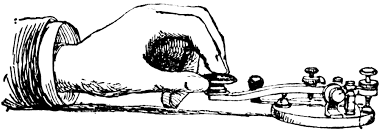
Extract from the RSGB’s World At Their Fingertips – P159:
“……..The 1933 N.F.D. event was organised on a District basis with an
“A” station (1.7 and 3.5 Mc/s) and a “B” station (7 and 14 Mc/s)
operating from each of the eighteen Districts. The winners were
West London (District 15) with a score of 364 points but their tactics
in attaching their aerials to the masts of an old commercial station
(Northolt), were severely criticised by many other Districts. Needless
to say the rules (which had not been specific on the question of aerial
height) were amended before the 1934 event took place. Second place
in 1933 was taken by the Scottish District, centred on Glasgow, with a
score of 357 but the Edinburgh group obtained the very high score of
209 points from the efforts of their single “A” station. “When the
actual day came” wrote a Bulletin scribe in the August 1933 issue,
“motorcars of all types, caravans, bicycles, donkey -carts and, in fact
every conceivable mode of transport seems to have been pressed into
service…………..”
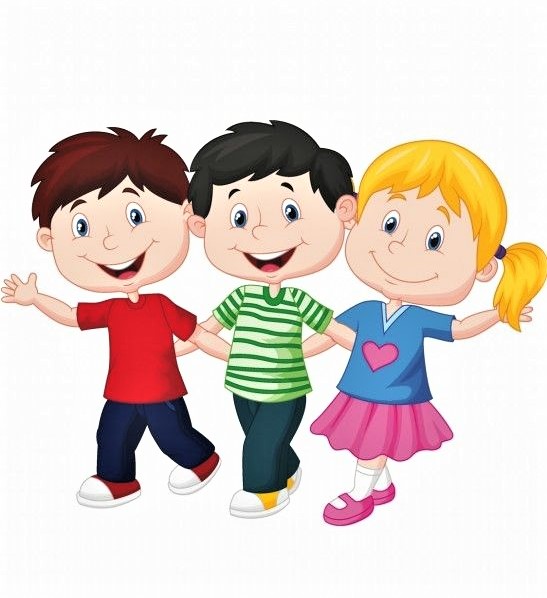
April 1961 in The Glasgow’s Kelvin Hall, contributing to an exhibition about schoolboy’s pastimes and interests, Tommy GM3EDZ set-up an amateur radio exhibition station using the special callsign GB3KH (Kelvin Hall); consisting of his Hallicrafters SX100 transmitter & HT37 receiver.
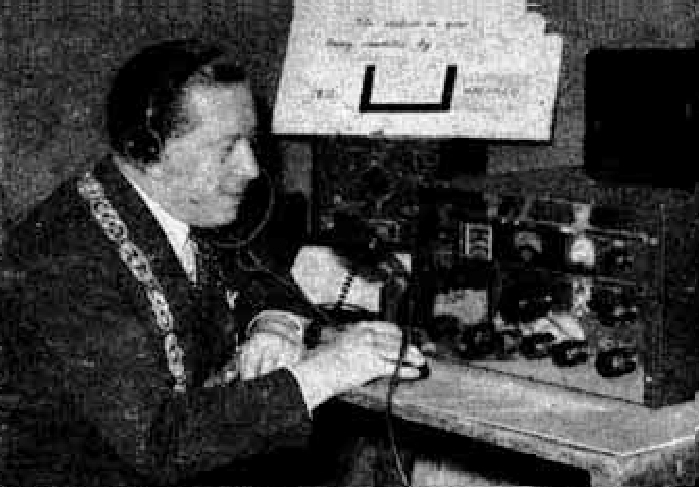
As part of the Festival of Britain in 1951, Glasgow amateurs staged the Scottish Amateur Radio Exhibition………..READ MORE.
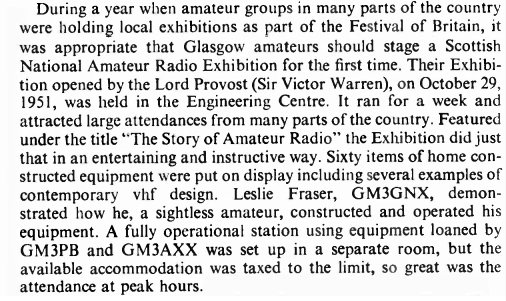
December (2020) is the 60th Anniversary of a well ‘Kent’ beacon in Kent. CLICK above for more info.

When the City & Guilds dropped the RAE (The Radio Amateurs Exam) and the RSGB/RCF took up the challenge, Club members were of the opinion that WoSARS in Rose Street did not have suitable facilities to run training courses and exams.
Following on from Ross GM7WED & Eugene G(M)0VIQ’s initial attempts, Alex GM7OAW took up the challenge, and make a start with running a Foundation Course on Friday nights (at Rose Street).
At that time the Foundation exam could be held anywhere, but the Full and possibly the Intermediate exams had to be at a registered exam centre. To overcome this shortfall, Alex applied to the RSGB for WoSARS to become an ACCREDITED Club & Centre, which was approved as in April 2005; with continuous training courses at all three levels being provided until the SOLDER GROUP was established a few years later (within the Electron Club).
For the exams, Alan GM4TOQ and Pat 2M1CKE were the regular invigilators (with Sam GM4BGS latterly taking over from Pat).
(Thanks Alex GM7OAW for background information)
And our present (2020 onwards) Training & Exam Secretary is Bill 2M0WWC. For further information checkout our LICENCE TRAINING Page.
© 2019-2023 WoSARS.Club